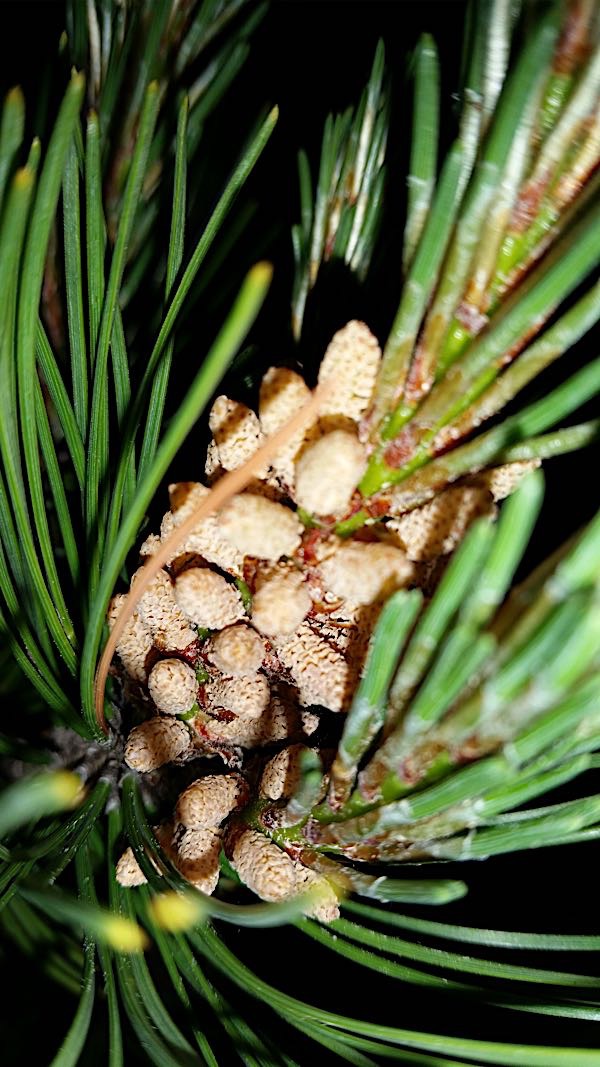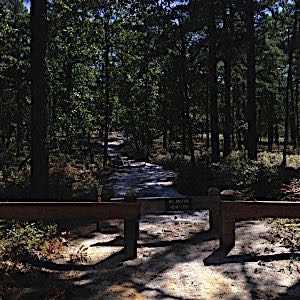Uncategorized
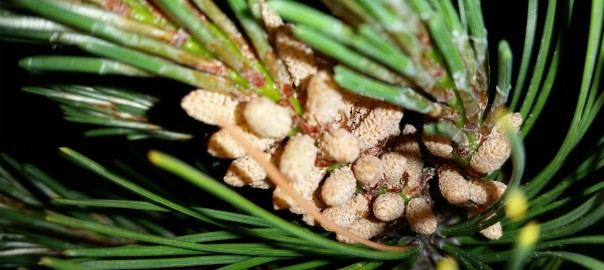
May 19, 2016. Dvorin & Goldstein Field Questions: Pollen & Allergy Misery
Today’s only official Pollen & Mold Spore Counts for the Delaware Valley:
Tree Pollen is Very High. Even though there was light rain in our region, tree pollen volume increased. This is primarily due to a surge in Pine Tree pollen which today accounts for nearly 60% of all tree pollen volume. It’s difficult to comprehend, but today there’s more than 20 times as much Pine tree pollen in our local air samples compared to yesterday. Mulberry tree pollen is edging out Oak—together, however, Mulberry and Oak tree pollen account for another estimated 35% of all tree pollen.
According to Dr. Dvorin, the peak of Pine Tree pollen is close, but still hasn’t arrived—more info to come on Pine Pollen Allergy!!
Grass Pollen remains steady at Moderate levels.
Outdoor Mold Spores doubled in volume and are Very High.
The Questions:
Dr. Dvorin came into work early today so that he could not only collect and count today’s air samples, but also so that he could answer questions from subscribers who receive The Asthma Center’s Daily Pollen and Mold Spore Count direct to his or her inbox. Likewise Dr. Goldstein started his day early to help address the questions that are pouring into The Asthma Center.
We hear the same questions (and sneezing) from members of the media, cashiers at our local 7-11s and WaWas, and the person sitting next to us on our commuter train, and the list goes on and on. We also hear the same questions from our patients (new and current) who are looking to The Asthma Center for ways to find relief from allergy misery.
“And the two questions I am most often asked: why are my symptoms so bad this year and when will tree pollen ‘lighten up or end’? Another question I hear is why can’t I ‘forecast’ the pollens or at least make a ‘projection’? ” reports Dr. Dvorin.
“People want answers, they want to feel better, and they want to get outside!” says Dr. Goldstein.
After counting today’s sample, Dr. Dvorin spent time reviewing the 2016 Tree Pollen counts through today compared to other years. Based on more than 25 years of historical data, in a “typical” spring, tree pollen season would begin mid-March, peak volume would be observed during the last week of April-first week of May. The end of pollen from “hardwood” trees (including Oak) would be seen approximately by the end of the first week of June with Pine Trees pollen continuing until July.
“2016 [Spring Pollen Volume] has been anything but typical,” says Dr. Dvorin shaking his head. “It’s been a roller coaster with the weather and for pollen, particularly Tree Pollen, and dispersion in the air. There’s been disruption to the usual process with pollen released later in the day versus the typical early morning peaks. Just different, and–the peaks of Pine Tree Pollen and Grass Pollen still haven’t arrived. “
But there’s more to it than just the weather and pollen volume, Dr. Dvorin explains. “First there’s always things that change—when I’m helping individuals—new to our practice or a current patient–with spring hay fever symptoms get relief, we have to remember that a person’s sensitivity can change from year to year, and so can his or her response to a treatment plan.”
“Our board certified Allergists investigate quickly when an individual reports “this year I feel worse,” Dr. Dvorin adds. “Our bodies change, or exposure to allergens change, lots of things change, so investigation including allergy skin testing becomes essential. Sometimes a medication becomes ineffective or just doesn’t work any more or we need to try to maximize a medication regimen or consider the best treatment available, and that’s allergy shots!”
According to Dr. Goldstein, “Here’s why allergy shots make such a difference—Allergy shots are disease-modifying, which means they [allergy shots] don’t just treat the symptoms, but allergy shots prevent symptoms before they ever start.”
What Is The “Priming Effect” ?
It can be confusing when allergy symptoms persist even after exposure to a triggering allergen decreases or stops (for example, when pollen volume levels are lower or at the end of a particular pollen season.) The variable that must be then considered is the well documented and recognized phenomena of “the priming effect.”
Dr. Goldstein explains, “The ‘priming effect’ is set up during the early periods of exposure to a pollen (as in the beginning of tree pollen season). Depending on an individual’s level of allergic sensitivity, symptoms typically are experienced with higher levels of pollen. As the season progresses and exposure to the relevant pollen diminishes, “priming” accounts for why less pollen exposure in the air continues to provoke the same allergic misery.”
Another thing to consider with the “priming effect:” If an individual has allergies in the nose, eyes, and chest, once there is nasal, eye, or lung inflammation from an allergic trigger (like Tree Pollen), an individual will be more sensitive to even non specific irritants (pollutants, odors, smells) that normally would not trigger symptoms.
Dr. Dvorin on Pollen “Forecasts”
“I’m asked that again and again,” says Dr. Dvorin. “Number 1 reason—currently there is no published, scientifically validated model for pollen forecasting. Empirically, when we compare our pollen data with the forecasts that are out there—available on the internet and phone apps, the correlation is poor. When we take into account the symptoms experienced by the patients in our clinical practice, again, the correlation with pollen forecasts is poor.”
“We are working on a forecast model at The Asthma Center for metropolitan Philadelphia,” stated Dr. Dvorin. “I’m not saying it’s impossible, but a validated model is not available yet.”
What can you do?
“Follow our pollen counts and pollen blogs,” says Dr. Dvorin. “I’ll keep you as informed as I can about ‘what’s in the air, and be proactive about treatment—if you’re having a bad time now, find out exactly what you’re allergic to, and keep history from repeating itself!”
For those suffering from terrible allergies right now, if over-the-counter (OTC) medications are not helping, you may want to start thinking about ways to prevent “history repeating itself” next spring. For example, if you are allergic to tree or grass pollen, Allergy Immunotherapy (Allergy Shots) or perhaps oral immunotherapy grass tablets may be helpful to get through the grass pollen season next year. If you are allergic to multiple kinds of pollen (tree, grass, ragweed, and/or other weeds), allergy shots are extremely effective in reducing the acute symptoms of nasal allergy such as sneezing and congestion (just to name two.) Allergy shots are also beneficial if you have multiple pollen allergies and experience other symptoms such as fatigue, sinus headache, mental “fogginess,” and cough, which are all symptoms often associated with severe allergies.
Be sure to check back in for The Asthma Center’s Daily Pollen and Mold Spore Count, the Delaware Valley’s ONLY official count station which is certified by the National Allergy Bureau.
Subscribe
to receive our daily counts by email or check out some of our other blog posts to learn more about what is in the air, how it can affect you, and what you can do about it.
Make an appointment to see an allergist – Why Choose Us?
The best way to fight your allergies is to visit a board certified allergist, learn what your allergies are, create a treatment plan, and adjust as needed. No two allergy sufferers are alike, so don’t rely on over the counter medications when you could be targeting your symptoms with the help of our allergy experts!
More Info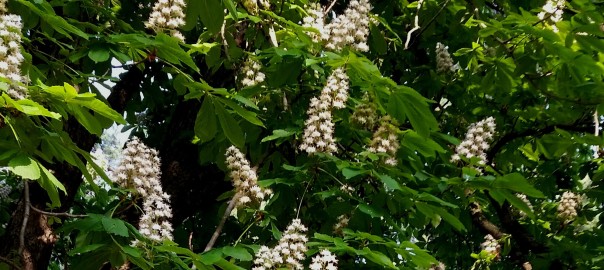
May 17, 2016. Aging Oak Reigns…Horse Chestnut Blooms
“Here’s how I know Oak Tree Pollen volume will be declining in next several days,” explained Dr. Dvorin after finishing today’s count.
“Oak pollen grains in the air samples right now are not as fresh they were, compared to a few days ago.”
“You can tell when pollen grains are older,” Dr. Dvorin explained further. “Oak Tree pollen grains are still identifiable and predominant in both Mount Laurel and Philly air samples today, but they look ‘older’– when pollen has been in the air for awhile, the grains start to break down, and compared to fresh and recently released pollen, they just look older.”
Today, Delaware Valley’s only official Tree pollen count is between 60-70% lower today than yesterday at 150 pollen grains per cubic meter of air/24 hours. Tree pollen remains Very High and even though volume is reduced, it can trigger moderate to severe symptoms. For more information on pollen volume and symptom correlation, check out Dr. Dvorin’s recent pollen blog: Pollen Volume: We’ve Got the Full Story.
Oak Tree Pollen decreased but is the predominant tree pollen in both the urban (Philadelphia, PA) and suburban (Mount Laurel, NJ) air samples. Pine Tree Pollen volume dropped an estimated 75%-80% while Mulberry Tree pollen volume dropped an estimated 82%-90%.
Grass pollen remains Moderate.
Outdoor Mold Spores decreased and are High.
“Once again the weather is playing a significant role in the process,” said Dr. Dvorin. “Overnight lows in the 30s for our area and more rain—we’ve seen this again and again over the past weeks. “
The rain knocks light pollen grain to the ground, at least temporarily, and the buds on trees close up in response to chilly temperatures. Then when the ground dries out, sometimes quickly, the wind picks or the electrical charge in the air changes (with thunderstorms and lightning), sudden bursts and increases in pollen in the air spell trouble for allergy sufferers.
Be sure to check back in for The Asthma Center’s Daily Pollen and Mold Spore Count, the Delaware Valley’s ONLY official count station which is certified by the National Allergy Bureau. Subscribe to receive our daily counts by email or check out some of our other blog posts to learn more about what is in the air, how it can affect you, and what you can do about it.
A Parisian Spring in Philly
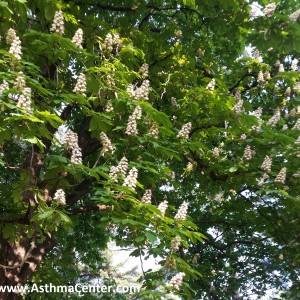
You may have heard before that Philadelphia’s city planning was based on Paris – just take a look at the Parkway! Another thing we have in common with Paris? Horse Chestnuts. These trees are very commonly planted in Paris and can be found on many grand boulevards and park settings. Our friend Tony Aiello, the Director of Horticulture and Curator at the University of Pennsylvania’s Morris Arboretum, helped us identify the Horse Chestnut you see in the picture above. This photo was taken on West River Drive by a member of The Asthma Center staff on her way home from work.
Horse Chestnut will grow to 40 feet tall with a spread of 40 feet. It will thrive in inner city environments due to its high tolerance of urban pollution. While the leaves begin to brown around the edges by late summer, these magnificent trees are stunning in May with pink flowers.
By 1904, an estimated ¼ of all trees in the Eastern US were American Chestnuts. However, in 1905 a fungus was discovered in the Bronx Zoo that quickly decimated the Chestnut tree population. Recently, thanks to cross breeding with Chinese Chestnuts that are resistant to the fungus, numbers are on the rise.
If you have one nearby, don’t fret too much. The pollen is heavy and doesn’t travel far. Also, don’t bother trying to eat the chestnuts. They are more bitter than their Chinese counterparts which we are accustomed to eating.
Make an appointment to see an allergist – Why Choose Us?
The best way to fight your allergies is to visit a board certified allergist, learn what your allergies are, create a treatment plan, and adjust as needed. No two allergy sufferers are alike, so don’t rely on over the counter medications when you could be targeting your symptoms with the help of our allergy experts!
More Info
May 16, 2016. Smokers Beware: New Study Supports Lung Screening
The good news is that cigarette smoking in the United States has decreased to 15-20% of the population from a high of over 50% in the 1970s. However, smoking continues to be a health threat not only for increased risk of cancer (lung cancer and other cancers including cancers of the lip, pharynx and oral cavity, esophagus, stomach, pancreas, larynx, cervix uteri (women), kidney and renal pelvis, bladder, liver, colon and rectum; and acute myeloid leukemia); but also increased risk for development of heart disease (high blood pressure, pulmonary embolism [PE], deep vein thrombosis [DVT], stroke, and peripheral vascular disease); chronic obstructive pulmonary disease (COPD); and other diseases such as type 2 diabetes, rheumatic arthritis, cataracts and macular degeneration.
To further our understanding of smoking related lung disease, a study recently published in the New England Journal of Medicine (NEJM May 12, 2016) found that 50% of so-called “healthy” smokers and ex-smokers (those with normal lung function by breathing tests) in fact have frequent lower tract respiratory exacerbation, activity limitations, and evidence of airways disease on lung CT. It is unclear if and when these individuals transition into conventionally defined COPD and how to treat these individuals.
At The Asthma Center, we screen all individuals who have a significant smoking history (greater than 20 pack year history smoking; 1 pack year = 1 pack/day x 1 year) by having them undergo a screening pulmonary function test (spirometry) and complete a simple, validated COPD Assessment Test (CAT) questionnaire. In the recently published study, such screenings can pick up those who are at greater risk of going onto to develop full blown COPD. Early intervention in this group may prevent progression of smoking related changes in the lungs.
If you are a current smoker and/or an ex-smoker, your risk for developing COPD and/or lung cancer are significant even if you have no symptoms. Even after smoking cessation, the risk for developing COPD and lung cancer remains although diminished compared to an active smoker. To understand your risk, it is worth getting these simple screenings– CAT questionnaire and lung spirometry– to identify whether you have smoking related lung disease in spite of not having chronic symptoms.
More Info
May 13, 2016. Combination Inhaler Safety Confirmed By New Study
Good news for anyone with persistent asthma!
The Asthma Center physicians were investigators in a breakthrough clinical trial which serves as the basis for a new asthma study just released yesterday in the New England Journal of Medicine (NEJM) which confirmed the safety of combination inhaled corticosteroids with long acting bronchodilators in patients with persistent asthma.
The results apply to products like Breo, Advair, Dulera and Symbicort. These longstanding inhaler products are commonly prescribed to help asthma sufferers get relief and keep asthma under control. For several years, these medications have been under the watchful eye of the Food & Drug Administration (FDA) amid concerns regarding risk of asthma related deaths and/or asthma exacerbations associated with the use of these combination inhalers.
This new 26 week study showed that salmeterol (Serevent) in combination with fluticasone (Flovent) [Comparable to Advair] did not have a significantly higher risk of serious asthma related events, including death, than those treated with Fluticasone alone.
In fact, subjects on combined salmeterol and Fluticasone had fewer asthma flares compared to those treated with Fluticasone alone.
In summary, The Asthma Center specialists continue to be confident in the efficacy and safety of inhalers which combine corticosteroids with long acting bronchodilators (Advair, Breo, Dulera, and Symbicort) in controlling asthma symptoms in those with persistent, moderate to severe asthma.
Our highly trained physicians, nurses and staff know that asthma symptoms can make day-to-day life difficult.
- Do you have trouble breathing or coughing?
- Difficulty making it through a work-out or playing sports?
- Chest tightness?
- Wheezing?
- Shortness of breath?
- Trouble breathing in the cold or seasonally?
Whether your symptoms are newly developed or have been around for years, The Asthma Center offers individualized treatment plans and comprehensive care for our patients. Click here to learn more about asthma, and how we help individuals with asthma Get Relief!
Subscribe to receive News from The Asthma Center, our Daily Pollen and Mold Spore Count, the Delaware Valley’s only Official count station which is certified by the National Allergy Bureau, Office Location & Shot Hour updates, and more.
Media inquiries: gwoodlyn@asthmacenter.com 215-569-1111.
More Info

May 11, 2016. Pollen Volume: We’ve Got the Full Story
“Volume is never the whole story.”
You’ve heard it before and you’ll hear it again from Dr. Dvorin.
Today, however, The Asthma Center is pleased to present Dr. Dvorin’s first local pollen count vlog, so you have a chance to hear him describe today’s pollen and mold count for the Delaware Valley.
Today, Delaware Valley’s only official Tree pollen count is lower today but still Very High. Trees don’t need to be at extreme levels in the air to trigger moderate to severe symptoms. For more information on local pollen counts and symptom correlation, see How We Count Pollen.
Dr. Dvorin saw concentrations of more than 400 grains per cubic meter of air. While it’s a decrease from earlier counts, there has been notable movement in what’s in the air.
Mulberry v. Oak
The battle for the Delaware Valley rages on. If this is the first you are hearing about it, catch up with Oak & Mulberry: Tree Pollen Battle Brewing.
Yesterday, Oak tree pollen constituted 80% of the pollen sample at our suburban station. Today, Oak tree pollen is reduced to 60% while Mulberry jumped from 1% to 20%. In our urban station, Mulberry jumped from 38% to 58% and Oak fell from 42% to 32%. Read our blog post “Street Tree Mulberry Struts it’s Stuff” to learn about Philadelphia’s street tree history and new places you can explore in the city. The differences in pollen predominance are relevant because not everyone experiences all tree pollens the same. A Very High day may feel worse for you than an Extreme day if the pollen you are most sensitive to increases. That is why The Asthma Center and Dr. Dvorin are committed to bringing you what’s in the air and not just volume.
Pineland Pollen Blitz Ahead
As we’ve noted before, Pine tree pollen has not yet fully arrived. Pine pollen has been known to dominate the air sample, especially with the Jersey Pinelands so close.
Grasses Advance Again
The levels go up steadily every day for Grass pollen. While they are still Moderate, expect a continuous climb as the season continues. For more tips on how to manage worsening Grass pollen symptoms, read “It’s Raining, Pouring: Local Pollen Count Soaring”.
Outdoor Mold Spores Drop Slightly from Very High to High.
No Ragweed or Other Weed Pollen are Seen.
What Can You Do?
Be sure to check back in for The Asthma Center’s daily Pollen and Mold Spore Count, the Delaware Valley’s only Official count station which is certified by the National Allergy Bureau. Subscribe to receive our daily counts by email or check out some of our other blog posts to learn more about what is in the air, how it can affect you, and what you can do about it.
Get Relief-Saturday appointments are available!
The best way to manage your allergies is to find out exactly what’s causing your symptoms. The Asthma Center has 9 locations in PA & NJ with the following Saturday hours in addition to our normal Monday – Friday business hours.
May 14: the Mount Laurel, NJ location will be seeing patients.
May 14: the Hamilton, NJ location will be seeing patients.
May 14 and June 4: the Langhorne, PA office will be seeing patients.
More Info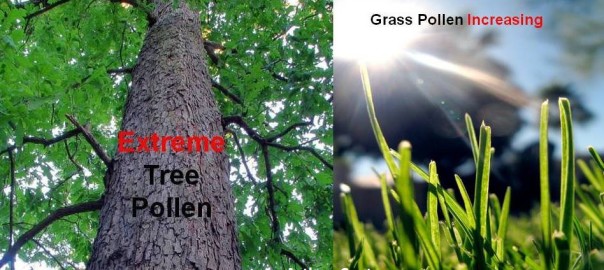
May 9, 2016. Extreme Tree +More Grass & Molds = Misery Monday
Tree pollen levels are extreme today. When pollen volume reaches the extreme range, there is the potential for severe allergy symptoms.
“Oak Tree Pollen looks like it’s in the peak phase which will continue for the next seven days, and then I would expect Pine Tree Pollen to dramatically increase,” Dr. Dvorin reports after finishing today’s local pollen count.
“Grass pollen is up, and I expect it to keep increasing—historically, our area sees the peak of the Spring Grass Pollen season right before Memorial Day, and Outdoor mold spores were increased today too, probably due to all the rain we had for more than a week,” he warned.
Tree Pollen is Extreme.
Oak Tree Pollen continues as the principal tree pollen in the air in the Delaware Valley accounting for nearly 90% of all tree pollen in the suburban (Mount Laurel, NJ) air sample and more than 75% in the urban (Philadelphia, PA) air sample.
Mulberry Tree Pollen increased in both air samples. Of note however, Mulberry tree pollen once again exhibits a stronger presence in the Philadelphia, PA air sample. (For more information read “Street Tree Mulberry Struts it’s Stuff” )
Birch Tree Pollen decreased in both air samples and today represents only an estimated 3% of overall tree pollen.
Pine Tree Pollen is slightly increased. Other tree pollen observed include Ash, Juniper/Cedar, Hemlock, Hickory/Pecan, Sweet Gum, Sycamore, and Walnut.
Grass Pollen is Moderate.
For the fourth local pollen count in a row, Grass pollen increased again and is moderate.
Outdoor Mold Spores are Very High.
Outdoor mold spores levels increased to very high.
Of note if you are allergic to outdoor mold spores, the “jump up” in the counts was dramatic for both air samples but more so in the suburban (Mount Laurel, NJ) air sample than in the urban (Philadelphia, PA) air sample.
No Ragweed or Other Weed Pollen is seen.
Grass Pollen Allergy Preparedness: More Important than Ever
It’s not uncommon for individuals with grass pollen allergy to also have other allergic sensitivities. In fact, in The Asthma Center’s 25 years of allergy skin testing, it is more common to see individuals who have multiple allergies rather than a sensitivity to grass pollen alone.
When local pollen counts are like today’s count with Tree pollen remaining extreme and potentially triggering severe symptoms and outdoor mold spores at very high levels, it is crucial to be prepared for Grass Pollen Allergy.
What Can You Do?
-
Recognize the symptoms
Many individuals recognize the “typical” spring allergy symptoms triggered by grass and tree pollen such as sneezing, itchy and watery eyes, and congestion. Less commonly recognized is the fact that grass pollen may be the source behind puffy eyes (eye allergy) and contact skin or rashes (skin allergy.) Many individuals are allergic to both trees and grass, making this time of year particularly miserable (don’t miss our recent blog: Blue Skies, Red Eyes)
-
Define your allergy triggers
At The Asthma Center, we know that no two people are exactly alike – which is why our evaluations and treatment programs are customized and tailored to fit each patient’s allergies, asthma, and sinus needs and concerns. Grass pollen sensitivity is just one part of our Allergy Skin Test. Based on our board certified Allergists clinical experience and Dr. Dvorin’s historical aeroallergen data, our team of specialists can help determine your level of sensitivity to the most common grasses in the Delaware Valley including June, Kentucky Blue, Meadow Fescue, Orchard, Perennial Rye, Redtop, Sweet Vernal, and Timothy.
-
Review your treatment plan for maximum symptom management
It’s not too late to Get Relief and feel better!
Grass pollen allergy treatment options are similar to other pollen treatments, and many factors will play a role on what is the best treatment plan for you. If your allergies are making you miserable, it is best to see a qualified (board certified) allergists who can evaluate and help you manage your specific issues. Allergies are often mis-diagnosed with other non-allergic conditions but with the proper diagnosis and customized treatment, it is possible to get relief!
Allergy shots have been shown to be of help to some individuals with grass pollen allergy. Another form of immunotherapy, sub-lingual (where a tablet is dissolved under the tongue) has recently become available for the treatment of grass pollen allergy. Unfortunately, studies have shown that this treatment works best when an individual has a single allergy but it is rare for an individual to only be allergic to grass pollen. In The Asthma Center’s experience, it is much more common for individuals to have multiple triggers with unique levels of allergic sensitivity and therefore a personalized approach is required in order to achieve the best outcomes and help our patients get relief.
To benefit from allergy shots or sub-lingual immunotherapy, these treatments should be started approximately three months before the season. While it may be too late to start allergy shots for the 2016 Spring season, it’s not too late to Get Relief, starting with allergy skin testing to determine your specific triggers and levels of allergic sensitivity!
-
Avoid or Limit Grass Pollen Exposure
The first step in avoiding or limiting grass pollen exposure is to know when grass pollen is present in the air. Dr. Dvorin collects, counts, and reports local air samples for the Delaware Valley every day Monday through Friday (check back in daily or subscribe to receive local pollen and mold spore counts by email.)
Grass pollen tips / Does the smell of cut grass bother you?
Mowing your lawn regularly can help cut down on the pollination of grasses on your property. However, many people experience allergy symptoms when exposed to the smell of freshly cut grass. Allergic reactions to mowed grass are more likely from the non-pollen parts of the grass containing allergenic proteins or molds being stirred up in the mowing process. When you mow your lawn, allergen concentration of this type will dramatically increase for a short period of time during and immediately after you mow. So, mowing your lawn will often be beneficial in the long-term, though it may aggravate your allergies short-term. Reactions to cut grass sometimes can go beyond the Spring grass pollination season as well. Again, this is not due to grass pollen but from exposure to mold spores or reactions to other grass antigens in the blades of grass.
You should also:
- Wear long sleeves and long pants when mowing the grass. Be sure to shower & wash your hair afterwards.
- Limit time outdoors during the early morning hours when the most pollen is released
- Sleep with windows closed and drive with windows up (Don’t miss our recent blog Shut the Door, Seal the Windows )
- Beware of tracking grass pollen into your home (kids, pets especially, newspaper sleeves, and on shorts and jackets)
- Shower and wash your hair after extended outdoor exposure
-
Know Your Local Pollen Count
Be sure to check back in for The Asthma Center’s daily Pollen and Mold Spore Count, the Delaware Valley’s only Official count station which is certified by the National Allergy Bureau. Subscribe to receive our daily counts by email or check out some of our other blog posts to learn more about what is in the air, how it can affect you, and what you can do about it.
Get Relief-Saturday appointments are available!
The best way to manage your allergies is to find out exactly what’s causing your symptoms. The Asthma Center has 9 locations in PA & NJ with the following Saturday hours in addition to our normal Monday – Friday business hours.
May 7 and May 14: the Mount Laurel, NJ location will be seeing patients.
May 14: the Hamilton, NJ location will be seeing patients.
May 14 and June 4: the Langhorne, PA office will be seeing patients.
More Info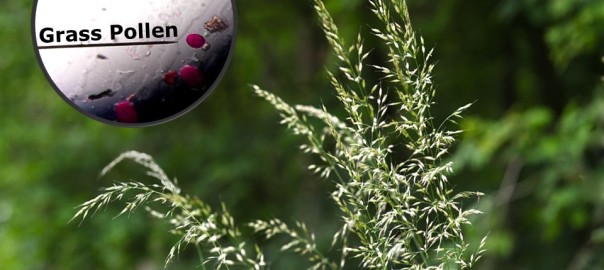
May 6, 2016. It’s Raining, Pouring: Local Pollen Count Soaring
“All it took was sunshine for a few hours yesterday,” says Dr. Dvorin, “I even noticed more pollen in the afternoon.”
Tree pollen levels are extreme today. When pollen volume reaches the extreme range, there is the potential for severe allergy symptoms. Tree pollen volume nearly tripled in our air in the Delaware Valley with today’s count over 1300 cubic meters of air/24 hours (any count above 1000 is extreme – see How We Count Pollen)
Tree Pollen (Extreme)
Oak Tree Pollen continues to dominate the counts consisting of nearly 80% of tree pollen seen in both the urban (Philadelphia, PA) and suburban (Mount Laurel, NJ) air samples.
“Heavy Oak tree pollen, no question,” says Dr. Dvorin, after counting today’s air samples. “And more Birch, and quite a variety of 8 other kinds of tree pollen as well.”
Birch represents an estimated 16% of overall tree pollen. Other tree pollen observed include Ash, Juniper/Cedar, Hemlock, Mulberry, Pine, Sycamore, and Walnut.
Grass Pollen (Moderate)
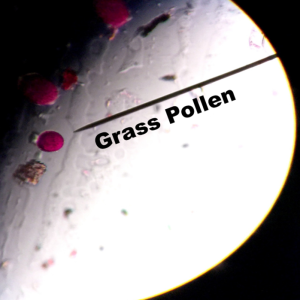
Grass pollen volume increased again for the third day in a row and is moderate.
Pictured above is an image of a grass pollen grain from today’s local air sample viewed through Dr. Dvorin’s microscope.
“Even the smallest amounts of grass pollen can cause symptoms in those who are extremely sensitive,” says Dr. Dvorin.
Why this sudden, steady rise? Because grasses are starting to pollinate. According to Dr. Dvorin’s historical data, grass pollen typically appears in early April, peaks during the month of May, and then gradually declines in June. This means that those with severe grass allergies have not yet begun to experience the peak of grass pollen this spring.
Outdoor Mold Spores (High)
Outdoor mold spores decreased a little again today and is high.
No Ragweed or Other Weed Pollen is seen.
What’s Ahead?
More rain, and possibly thunderstorms, are the forecast for our region for the rest of this Friday afternoon, and may possibly extend through the night into Saturday morning. The Delaware Valley experienced similar conditions earlier in the week which, contrary to what many expected, may have contributed to more pollen in the air (Dr. Dvorin explains how thunderstorms can influence pollen release in our recent blog “Grains Against the Rain.”
The Sun’ll Come Out Tomorrow
Most metrological forecasts for the Delaware Valley call for sunshine and warmer temps both on Saturday and Sunday afternoons, which is great news for all of us with weekend in plans. That’s the good news. Unfortunately, given Dr. Dvorin’s historical data and expertise, pollen levels will likely continue to provoke severe symptoms for those with allergies and asthma.
“It’s been an unusual season, with complicated weather patterns influencing the pollen process, up and down, and back up, “ he commented. “It’s bad [exposure to pollen], and it will get worse as things dry out and heat up. Grass is taking off, and we haven’t seen Pine tree pollen peak yet,” he warns.
What Can You Do? Be Pro-Active!
- Learn how to tell the difference
Sinusitis, Common Colds or Allergies? There’s are big differences between the three, though initial symptoms are often very similar to one another. Read more on Sinusitis Colds or Allergies.
- Grass pollen tips / Does the smell of cut grass bother you?
Mowing your lawn regularly can help cut down on the pollination of grasses on your property. However, many people experience allergy symptoms when exposed to the smell of freshly cut grass. Allergic reactions to mowed grass are more likely from the non-pollen parts of the grass containing allergenic proteins or molds being stirred up in the mowing process. When you mow your lawn, allergen concentration of this type will dramatically increase for a short period of time during and immediately after you mow. So, mowing your lawn will often be beneficial in the long-term, though it may aggravate your allergies short-term. Reactions to cut grass sometimes can go beyond the Spring grass pollination season as well. Again, this is not due to grass pollen but from exposure to mold spores or reactions to other grass antigens in the blades of grass.
You should also:
- Wear long sleeves and long pants when mowing the grass. Be sure to shower & wash your hair afterwards.
- Limit time outdoors during the early morning hours when the most pollen is released
- Sleep with windows closed and drive with windows up (Don’t miss our recent blog Shut the Door, Seal the Windows )
- Beware of tracking grass pollen into your home (kids, pets especially, newspaper sleeves, and on shorts and jackets)
- Shower and wash your hair after extended outdoor exposure
- Mother’s Day Flowers & Potential Allergens
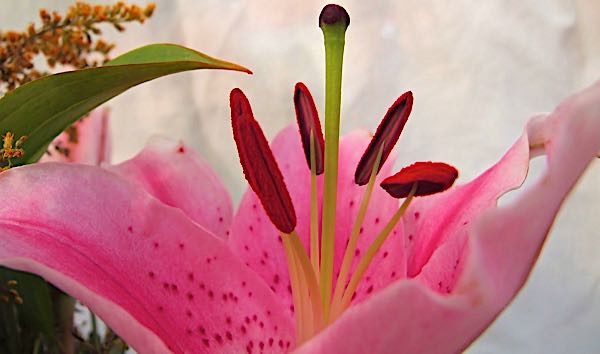
Flowers are synonymous with two things: Mother’s Day and allergies. With Mother’s Day around the corner, before you bring ornamental flowers indoors, it may be worthwhile to remove as much pollen as possible by removing the stamen.
For a less symptomatic weekend with Mom, try one of these flowers more suited for allergy sufferers.
- Begonia
- Clematis
- Columbine
- Crocus
- Daffodil
- Geranium
- Hydrangea
- Iris
- Lily
- Periwinkle
- Rose
- Tulip
- Zinnia
The pollen from flowers used in arrangements is heavier than tree, grass and weed pollen. This means that usually it is less of a trigger for allergy and asthma symptoms. However, there are several things to keep in mind when giving or receiving flowers as a gift:
- It’s a good idea to resist the temptation of placing your nose directly in a bouquet of flowers or touching the flowers, since direct contact on the hands, other parts of the skin, eyes and nose may trigger allergy symptoms.
- The fragrance from some plants may also have a very significant irritant effect if you have respiratory allergies and/or asthma.
- Reduce symptoms by avoiding the “worst offenders” such as chamomile, chrysanthemums, daisies, goldenrod, and sunflowers. Learn more here: Tips for Allergy Free Gardening
Make an appointment to see an allergist – Why Choose Us?
The best way to fight your allergies is to visit a board certified allergist, learn what your allergies are, create a treatment plan, and adjust as needed. No two allergy sufferers are alike, so don’t rely on over the counter medications when you could be targeting your symptoms with the help of our allergy experts!
Next Pollen and Mold Spore Count: Monday 5/9/2016
Be sure to check back in for The Asthma Center’s daily Pollen and Mold Spore Count, the Delaware Valley’s only Official count station which is certified by the National Allergy Bureau. Subscribe to receive our daily counts by email or check out some of our other blog posts to learn more about what is in the air, how it can affect you, and what you can do about it.
Get Relief-Saturday appointments are available!
The best way to manage your allergies is to find out exactly what’s causing your symptoms. The Asthma Center has 9 locations in PA & NJ with the following Saturday hours in addition to our normal Monday – Friday business hours.
May 7 and May 14: the Mount Laurel, NJ location will be seeing patients.
May 14 and June 4: the Langhorne, PA office will be seeing patients
More Info
May 4, 2016. Oak & Mulberry: Tree Pollen Battle Brewing
Tree pollen remains Very High today in the Delaware Valley. Overall volume of Tree pollen decreased 23%-40% with a greater reduction in overall volume noted in The Asthma Center’s urban (Philadelphia, PA) air sample versus the suburban (Mount Laurel, NJ) air sample.
Oak Tree Pollen, again today, is the principal tree pollen seen in both air samples. Of note, however, in the Philadelphia, PA pollen count, Mulberry Tree Pollen volume actually increased (nearly tripled compared to yesterday’s count) and is a close “2nd Place” to Oak Tree Pollen. In both the NJ and PA pollen counts, Pine tree pollen is the 3rd highest contributor to overall volume. “Volume is never the whole story,” reminds Dr. Dvorin, The Asthma Center’s certified pollen and mold spore counter.
Be sure to catch up on our last blog “Grains Against the Rain: More Tree Pollen for NJ & PA.”
Grass pollen is slightly increased to Low levels. If you are allergic to grass pollen, there are two things you should keep in mind:
- It’s crucial to recognize your symptoms when they first appear and to be knowledgeable about your management and treatment options—if you are extremely sensitive or allergic to grass pollen (Allergy Skin Testing), exposure to even minimal amounts of this aeroallergen may trigger symptoms.
- Based on Dr. Dvorin’s historical pollen data, Grass pollen seen during the Spring typically peaks in May. Given current meteorological conditions in our region, today’s slight increase in Grass pollen suggests that as soon as the ground dries out, a dramatic surge in Grass pollen can be expected.
Outdoor mold spores today are slightly decreased but remain Very High.
What’s Ahead?
Right now, conditions in our region are dry but cloudy and cool. Daytime high temperatures are expected to remain unseasonably cool until Saturday. More clouds and possible rain showers are also in most forecasts for the Delaware Valley through Saturday morning with the sun expected to finally break through Saturday afternoon, just in time for Mother’s Day.
If you’re starting to make Mother’s Day weekend plans, be sure to check back daily for The Asthma Center’s daily Pollen and Mold Spore Count, the Delaware Valley’s only Official count station which is certified by the National Allergy Bureau. Subscribe to receive our daily counts by email or check out some of our other blog posts to learn more about what is in the air, how it can affect you, and what you can do about it.
What Can You Do?
“An Ounce of Prevention is Worth a Pound of Cure.” Benjamin Franklin
Philadelphia’s own Benjamin Franklin wore many “hats” during his lifetime, and much of his wisdom still applies today. The above quote attributed to him, for example, exemplifies what it means to be pro-active.
For those suffering from terrible allergies right now, if over-the-counter (OTC) medications are not helping, you may want to start thinking about ways to prevent “history repeating itself” next spring. For example, if you are allergic to grass pollen, Allergy Immunotherapy (Allergy Shots) or perhaps oral immunotherapy grass tablets may be helpful to get through the grass pollen season next year. If you are allergic to multiple kinds of pollen (tree, grass, ragweed, and/or other weeds), allergy shots are extremely effective in reducing the acute symptoms of nasal allergy such as sneezing and congestion (just to name two.) Allergy shots are also beneficial if you have multiple pollen allergies and experience other symptoms such as fatigue, sinus headache, mental “fogginess,” and cough, which are all symptoms often associated with severe allergies.
Get Relief-Saturday appointments are available!
The best way to manage your allergies is to find out exactly what’s causing your symptoms. The Asthma Center has 9 locations in PA & NJ with the following Saturday hours in addition to our normal Monday – Friday business hours.
- May 7 and May 14: the Mount Laurel, NJ office will be seeing patients.
- May 14: the Hamilton, NJ office will be seeing patients.
- May 14 and June 4: the Langhorne, PA office will be seeing patients.
More Info
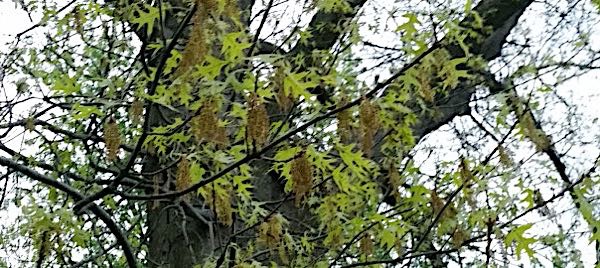
May 3, 2016. Grains against the Rain: More Tree Pollen For NJ & PA
“Today is yet another example of how weather, pollen, and allergy symptoms are all related,” says Dr. Dvorin as he finished counting today’s air sample.
“If you have allergies, you feel it. Tree pollen increased—it’s the height of the season, conditions were dry most of yesterday even though it was cloudy, and then there were those thunderstorms overnight,” he explains.
“I’m congested.
“Scratchy throat and I feel terrible.”
“My head, my head…Sinus Congestion…”
Co-workers, family members and friends are lamenting about their symptoms. Recent comments posted on The Asthma Center’s Facebook page echo this sentiment:
“I’m suffering horribly!”
“Feels like a hangover without any of the fun.”
“My head may blow up.”
Tree pollen increased today and remains very high. In the Delaware Valley, tree pollen counts of 60-999 pollen grains per cubic meter of air in a 24 hours period are very high and may cause moderate to severe symptoms. Compared to yesterday’s tree pollen count, overall volume increased approximately 25%.
Oak Tree Pollen continues to dominate the count and accounts for 76%-81% of all tree pollen in the air in New Jersey and Pennsylvania. There’s no shortage of Oak Trees in our area–pictured above is a Montgomery County Oak Tree with dangling catkins. To learn more about Oak catkins, read the recent pollen blog Shut the Door, Seal the Windows: Catkins Are Here
Birch, Mulberry and Pine comprise another 10%-12%. Other kinds of tree pollen present in the air include Walnut, Sycamore, Hickory/Pecan, and Sweet Gum.
Grass pollen is very low. Outdoor mold spores decreased slightly over the past 24 hours but remain high.
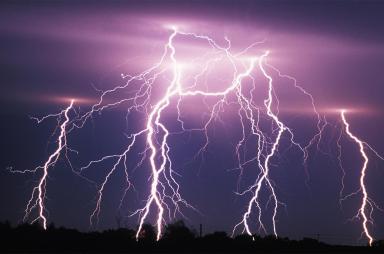 Yikes—Thunderstorms Can Mean More Pollen In the Air
Yikes—Thunderstorms Can Mean More Pollen In the Air
Sometimes, that’s true. You may have seen or been woken up last night by thunder, lightning, and periods of heavy rain in parts of the Delaware Valley. In last week’s blog, Thursday Tree Pollen Tale: Very High, Down Not Out, Dr. Dvorin discussed how weather changes like rain and falling temperatures can disturb the pollen process. Storms like those our area experienced overnight –Thunderstorms accompanied by lightning, winds and heavy rains–affect the process differently. First, winds lift, carry, and toss pollen about, sometimes violently. Lightning indicates a change in the movement of atmospheric electrical charges which may cause further anomalies in pollen release; when combined with winds, this can result in more pollen in the air with all of it traveling further. Acute asthma attacks have also been associated with thunderstorms.
What’s Ahead?
There is a light mist in the Delaware Valley, with more rain, and possibly thunderstorms, in the forecast for the next several days. We asked Dr. Dvorin again about “pollen forecasts” popular in the news and online today, some of which predicted low levels of pollen today for our region.
“They [ the pollen forecasts ] don’t seem to help,” Dr. Dvorin noted, “if you have allergies, the forecasts do not match what you feel because you’re affected by what is actually in the air.”
The accuracy and statistical correlation of pollen counts with pollen forecasts has never been proven, and that is why there has been no published, scientifically validated model for pollen forecasting.
Be sure to check back in for The Asthma Center’s daily Pollen and Mold Spore Count, the Delaware Valley’s only Official count station which is certified by the National Allergy Bureau. Subscribe to receive our daily counts by email or check out some of our other blog posts to learn more about what is in the air, how it can affect you, and what you can do about it.
What Can You Do?
“An Ounce of Prevention is Worth a Pound of Cure.” Benjamin Franklin
You may recall a story about a prominent scientist from Philadelphia (and kite experiment) who was also interested in the effects of lightning (and the movement of atmospheric electrical charges). Benjamin Franklin wore many “hats” during his lifetime, and much of his wisdom still applies today. The above quote attributed to him, for example, exemplifies what it means to be pro-active.
For those suffering from terrible allergies right now, if over-the-counter (OTC) medications are not helping, you may want to start thinking about ways to prevent “history repeating itself” next spring. For example, if you are allergic to grass pollen, Allergy Immunotherapy (Allergy Shots) or perhaps oral immunotherapy grass tablets may be helpful to get through the grass pollen season next year. If you are allergic to multiple kinds of pollen (tree, grass, ragweed, and/or other weeds), allergy shots are extremely effective in reducing the acute symptoms of nasal allergy such as sneezing and congestion (just to name two.) Allergy shots are also beneficial if you have multiple pollen allergies and experience other symptoms such as fatigue, sinus headache, mental “fogginess,” and cough, which are all symptoms often associated with severe allergies.
Get Relief-Saturday appointments are available!
The best way to manage your allergies is to find out exactly what’s causing your symptoms. The Asthma Center has 9 locations in PA & NJ with the following Saturday hours in addition to our normal Monday – Friday business hours.
- May 7 and May 14: the Mount Laurel, NJ office will be seeing patients.
- May 14: the Hamilton, NJ office will be seeing patients.
- May 14 and June 4: the Langhorne, PA office will be seeing patients.
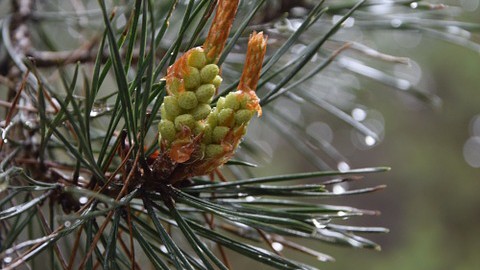
April 29, 2016. TGIF: Tree pollen Grains Increased Friday
“Trees aren’t through with us yet – so when you have a little bit of rain, it will only slow down the process – not stop it,” summarized Dr. Dvorin after analyzing today’s Pennsylvania and New Jersey air samples.
Tree pollen again today is very high. In the Delaware Valley, tree pollen counts of 60-999 pollen grains per cubic meter of air in a 24 hours period are very high and may cause moderate to severe symptoms.
Compared to yesterday’s air sample, today’s overall tree pollen intensified by approximately 33%. Thursday’s decreases in tree pollen volume were likely due to disturbances in the pollen process (rain and chilly temperatures.) Today’s “bounce back up” is no fluke or technical malfunction—during the early morning hours when most pollen is released into the air, weather conditions were dry in the Delaware Valley. Unfortunately for allergy and asthma sufferers, Tree pollen season is clearly not waning. As Dr. Dvorin said in yesterday’s blog, “Volume is never the whole story with pollen.” Likewise today, there are more clues that tree pollen season is not “on it’s way out.”
Oak Tree Pollen continues to unquestionably dominate the count; however, at approximately 77% of all tree pollen. While Mulberry and Birch tree pollen are present in percentages similar to yesterday, the big news, is that these species have been surpassed by increases in Pine tree pollen and Juniper/Cedar tree pollen which today take 2nd and 3rd place respectively in prominence. The surge in Pine pollen is one clue, and the variation in the composition of the air samples another clue—all pointing to the fact that Tree pollen season is not over. Based on his experience and historical data, Dr. Dvorin expects Pine tree pollen to peak sometime in the next 2 weeks.
Additionally, today’s grass pollen counts are very low, and outdoor mold spores remain high.
Did you know?
If you live in the Delaware Valley (or were born here and now live elsewhere), you know the Jersey Pine Barrens are a source of pride. Two things you may not know are:
- The New Jersey Pine Barrens are home to the biggest collection of Scrub or Pitch Pine on the US Eastern seaboard. Fossilized Pollen has been used to date this species back to the ice age!
- This large collection of Pine trees, whose pollen can sometimes at its peak be so thick it looks like a cloud of smoke, creates a unique challenge for allergy and asthma sufferers and the allergists who manage their care. We may take for granted that the Pine Barrens are part of our landscape and Pine pollen part of our air samples, but in many regions of the United States, this is not the case. In fact, in areas where pines are few, and pine pollen exposure minimal or nonexistent, pine pollen is not considered “allergenic.” While there may be some in our area who are still unaware of pine pollen and its effects, The Asthma Center includes pine tree pollen in our allergy skin test panel to determine allergic sensitivity.
Next Pollen and Mold Spore Count: Monday 5/3/2016
Be sure to check back in for The Asthma Center’s daily Pollen and Mold Spore Count, the Delaware Valley’s only Official count station which is certified by the National Allergy Bureau. Subscribe to receive our daily counts by email or check out some of our other blog posts to learn more about what is in the air, how it can affect you, and what you can do about it.
Get Relief-Saturday appointments are available!
The best way to manage your allergies is to find out exactly what’s causing your symptoms. The Asthma Center has 9 locations in PA & NJ with the following Saturday hours in addition to our normal Monday – Friday business hours.
- May 7 and May 14: the Mount Laurel, NJ location will be seeing patients.
- May 14 and June 4: the Langhorne, PA office will be seeing patients

